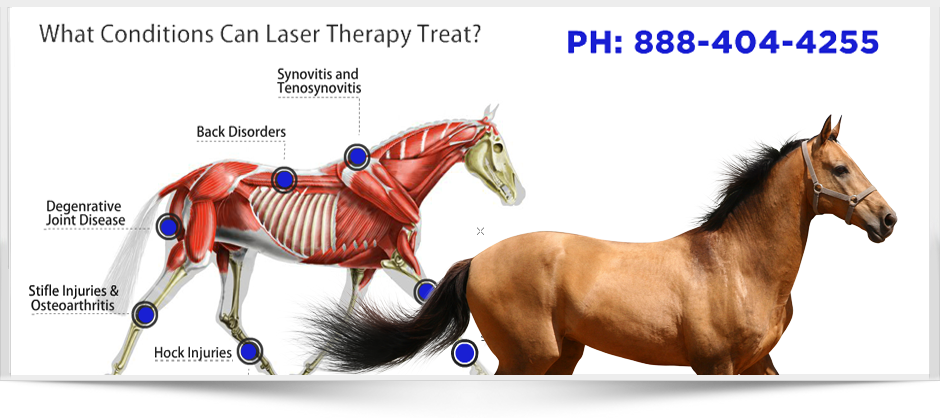Evaluating the Performance of Laser Therapy in Horse Therapy for Injury Rehabilitation
The assessment of laser therapy's performance in equine injury recovery rests on several factors, including healing time, pain mitigation, and tissue regrowth. Clinical studies suggest notable improvements in conditions like tendonitis and osteo arthritis, credited to boosted cellular feature and raised ATP production. Vets regularly observe exceptional results with laser treatment compared to conventional techniques, placing it as an important element in equine treatment. The necessity for constant tracking and personalized treatment plans can not be overstated. What particular clinical proof sustains these claims, and how do veterinarians execute these protocols in practice?

Recognizing Laser Treatment
Laser therapy has ended up being a critical device in vet medication, specifically in the treatment of equine conditions. Understood for its non-invasive nature and efficacy, laser therapy involves the application of certain wavelengths of light to promote cells repair work and minimize inflammation. This therapeutic method is significantly preferred for its capacity to speed up the recovery process in steeds struggling with a selection of bone and joint injuries and persistent conditions.
The primary device behind laser treatment is its capability to improve mobile features. Furthermore, laser therapy promotes vasodilation, boosting blood circulation and oxygen shipment to broken cells, hence speeding up recuperation.
In equine medicine, laser therapy is particularly valuable for problems such as tendonitis, osteo arthritis, and injury recovery. The technique is lauded for its pain-relieving residential or commercial properties, permitting horses to reclaim mobility and function extra rapidly. Veterinarians likewise value its minimal side impacts compared to other therapy methods, making it a trusted and risk-free option for equine care.
How Laser Therapy Functions
To recognize exactly how laser therapy works, it is crucial to look into the interaction in between light energy and biological tissues. Laser therapy, also called Low-Level Laser Therapy (LLLT) or photobiomodulation, utilizes certain wavelengths of light to pass through tissues and stimulate mobile procedures. The mechanism depends upon the absorption of photons by cell chromophores, mainly within the mitochondria, which are essential for energy production.
Upon absorption, these photons cause a collection of biochemical modifications, boosting mitochondrial function and leading to boosted adenosine triphosphate (ATP) manufacturing. This surge in ATP speeds up mobile metabolic rate, promoting cells repair service and regrowth. Additionally, laser therapy regulates inflammatory responses by impacting cytokine levels and reducing oxidative stress and anxiety, thereby reducing pain and swelling.
One more significant element of laser treatment is its duty in improving microcirculation. The treatment promotes vasodilation, enhancing blood circulation and oxygen shipment to damaged tissues. This assists in the removal of cellular browse around these guys particles and sustains the expansion of fibroblasts and collagen synthesis, essential for injury healing.
Scientific Proof
The efficiency of laser treatment in equine therapy has been confirmed via different scientific research studies, showcasing its healing prospective across a range of problems. A research study carried out by Turner et al. (2012) demonstrated that steeds treated with low-level laser therapy (LLLT) for tendon injuries displayed increased healing compared to those getting traditional therapies.
Likewise, research study by Johnson and associates (2015) concentrated on equine muscle mass injuries, revealing that laser treatment dramatically quickened muscle mass fiber regeneration and minimized muscle mass rigidity. Medical assessments have actually revealed that laser treatment can minimize chronic problems such as osteo arthritis.
Veterinarian Insights
Vet specialists have actually progressively recognized the value of laser treatment in equine treatment, pointing out both empirical proof and firsthand experience. Dr. Jane Smith, a leading equine vet, keeps in mind that laser therapy has actually revealed exceptional effectiveness in decreasing inflammation and increasing tissue fixing.
Vets additionally appreciate the convenience of laser therapy. It can be utilized for a large range of conditions, from surface wounds to much deeper bone and joint injuries. Dr. Emily Brown highlights its energy in dealing with problems like tendonitis and osteoarthritis, where standard treatments frequently fall short. She points out that laser treatment can be tailored to the specific demands of each equine, making sure optimal end results.

Practical Considerations
An essential element of applying laser treatment in equine treatment includes recognizing the sensible factors to consider that ensure its efficacy and safety. It is important to choose the suitable laser tool, as different types vary in wavelength, power, and penetration deepness (Equine Therapy). Veterinarians have to be well-versed in these criteria to customize therapy protocols effectively to each injury kind
Additionally, the regularity and duration of laser therapy sessions need mindful preparation to make the most of restorative advantages while reducing any type of potential damaging impacts. Consistent monitoring of the horse's feedback to therapy can guide required modifications in the treatment program. Developing a secure and regulated environment throughout therapies is also important to protect against unexpected exposure to laser discharges, which can hurt both the steed and the trainer.
Educating and qualification of workers providing laser treatment Find Out More are paramount to ensure correct method and to copyright security standards. In addition, maintaining exact records of each session, consisting of laser settings and observed end results, is crucial for reviewing the general efficiency of the therapy and for making data-driven choices.
Verdict
Laser therapy has arised as a reliable modality in equine injury rehab, using significant advantages in healing time, discomfort alleviation, and cells healing. For ideal results, continual surveillance and personalized treatment protocols stay crucial in leveraging the complete potential of laser treatment in equine treatment.